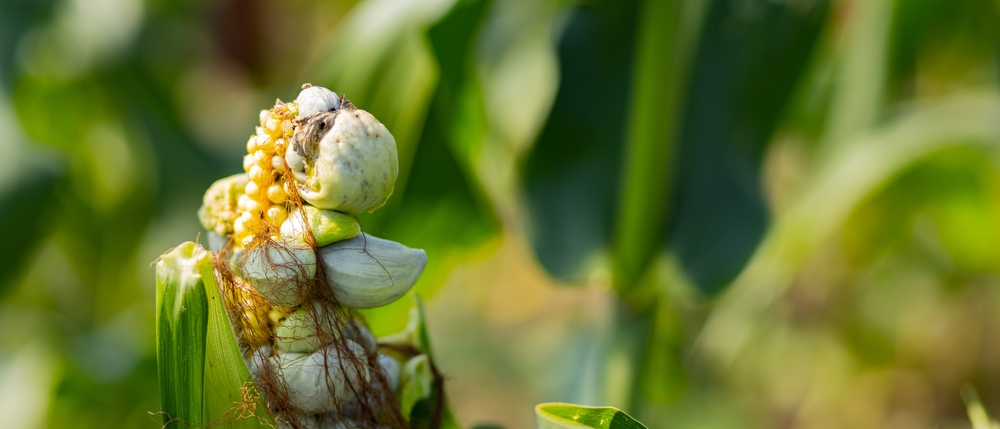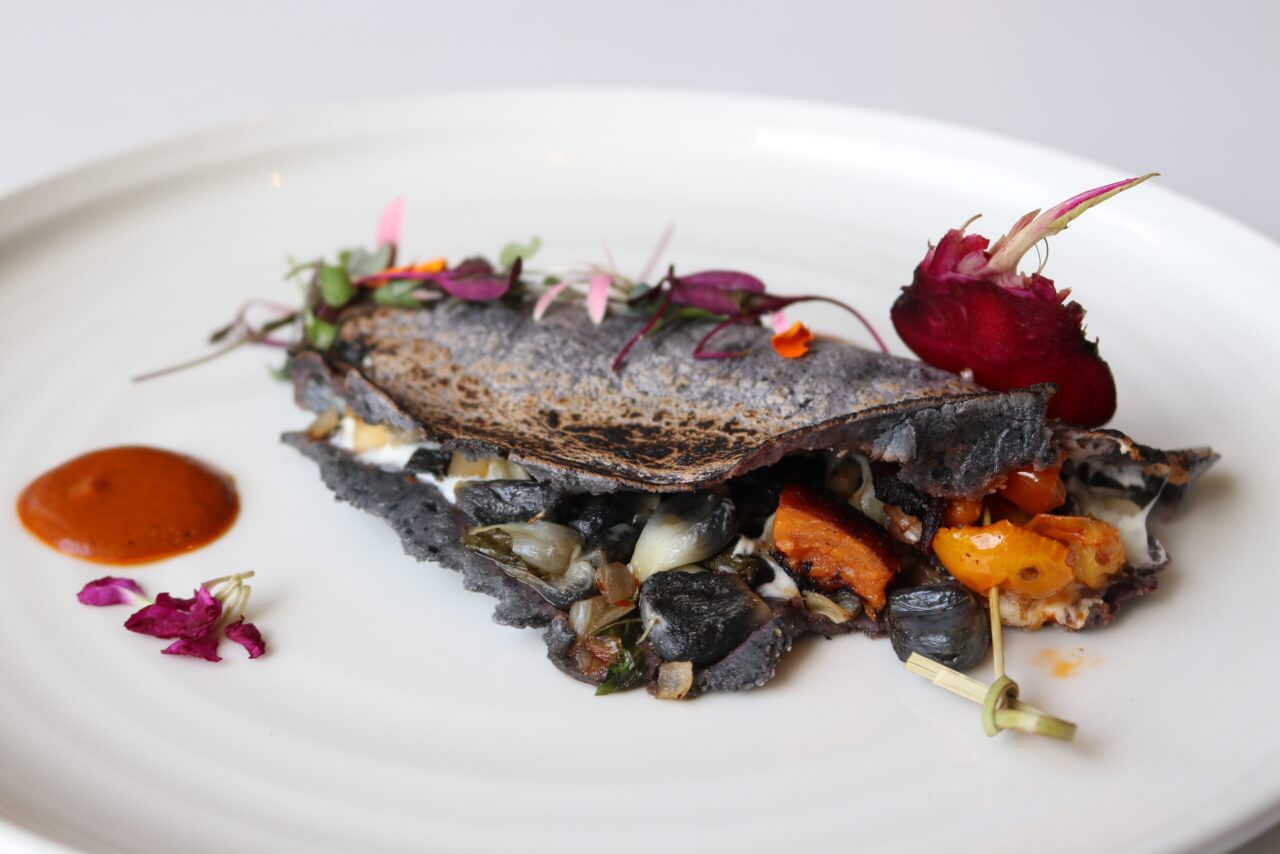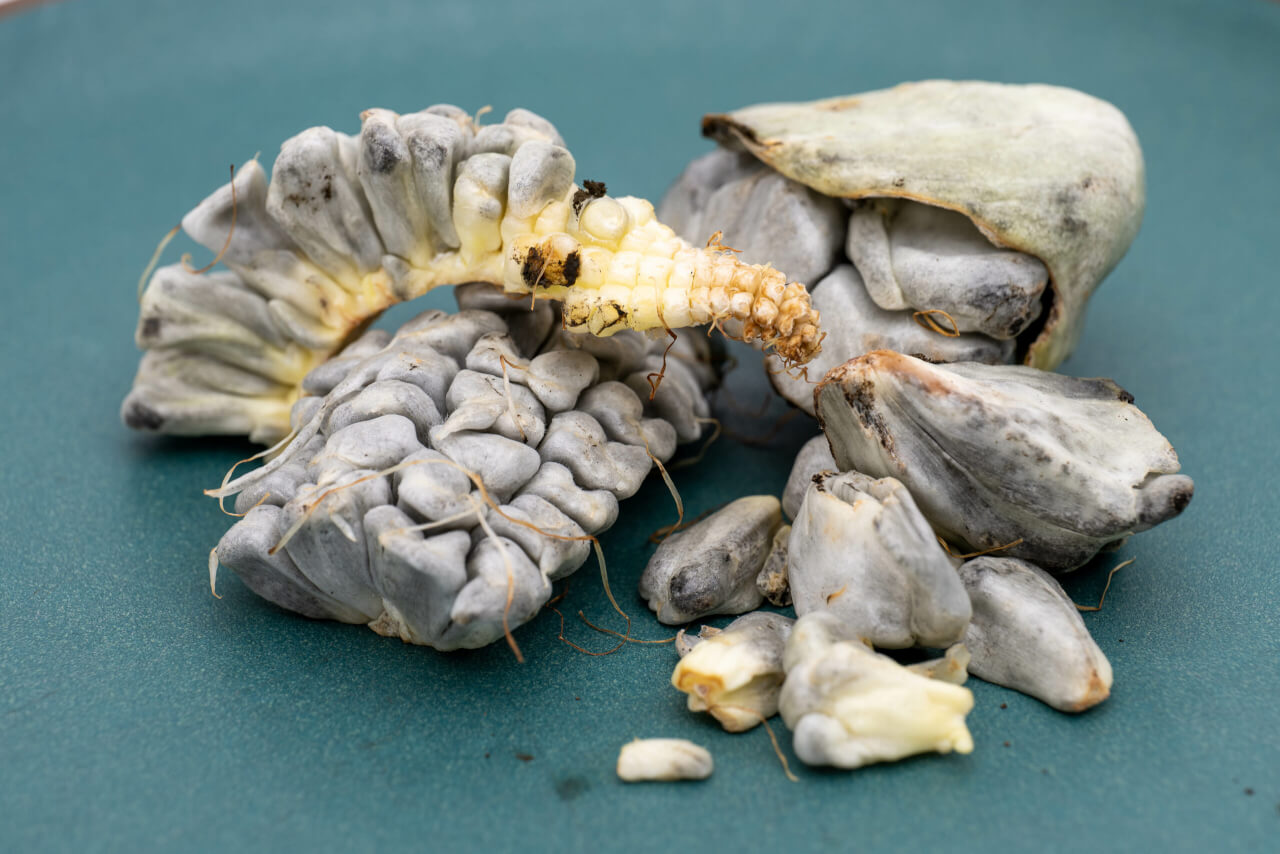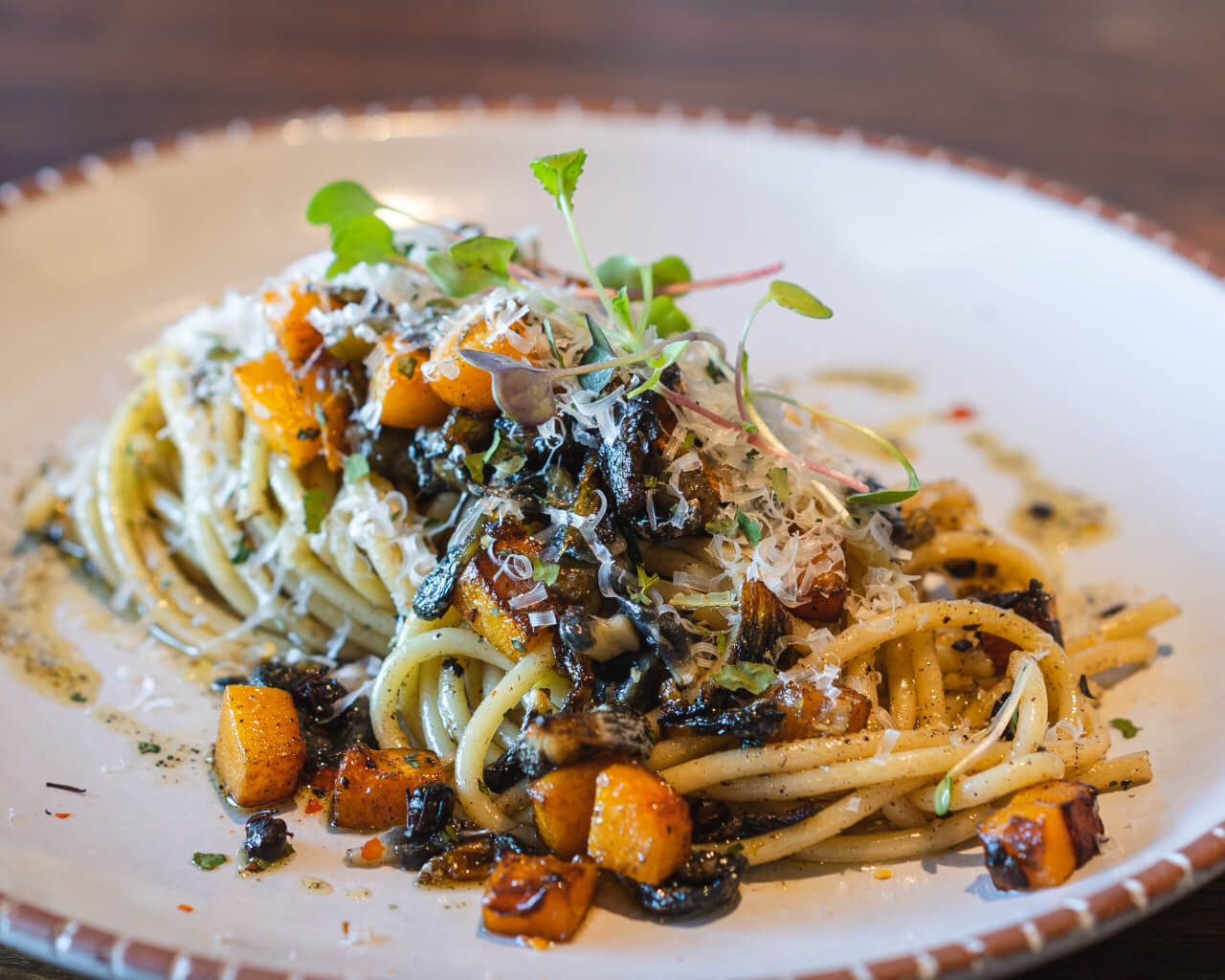Huitlacoche, a Mexican Fungus, is Popping Up On Restaurant Menus Across the US
The delicacy is gaining prominence outside of Mexico, but seasonality, stigma and the challenges of importing make it a rare treat.
Huitlacoche, a Mexican Fungus, is Popping Up On Restaurant Menus Across the US
The delicacy is gaining prominence outside of Mexico, but seasonality, stigma and the challenges of importing make it a rare treat.

Huitlacoche, a corn fungus, is a delicacy, but can be hard to findby Shutterstock
Carolina Aboumrad, a restaurant supplier, was having lunch at a Mexican eatery in Los Angeles. While chatting with the server, she mentioned she sources truffles, rare mushrooms and other specialty ingredients for chefs. The next thing she knew, the restaurant’s own chef was coming out of the kitchen. “He told me, ‘my dream ingredient is huitlacoche. I cannot get it anywhere except for in a can,’” Aboumrad recalls.
A prized pre-Hispanic ingredient in Mexico, huitlacoche is a bluish-gray fungus that grows on corn kernels and causes them to swell into bulbous masses, usually after rainy seasons. The ingredient’s seasonality, as well as the way it originates from corn, has made huitlacoche a treasured food and a symbol of bounty in Mexican culture. “Corn was the food of the gods and allowed the Aztecs to flourish,” explains Aboumrad. “When huitlacoche came out, it was like a gift from the gods.”

With its deeply earthy, smoky flavor, the tender, spongy ingredient is considered a culinary delicacy in Mexico. Vendors on the streets of Mexico City fold huitlacoche into blue corn tortillas to make quesadillas, while home cooks might add the ingredient to sauces and soups, fold it into tacos or wrap it inside tamales. Hugo Ortega, the chef behind the Houston restaurant Xochi, especially enjoys the rich flavor of huitlacoche when sautéed with eggs, a recipe he learned as a boy while living with his grandmother in Acatlán de Osorio, a city in the east-central Mexican state of Puebla. “The silkiness and earthiness,” he says, “it’s delicious.” Thanks to its high protein and fatty acid contents, huitlacoche is also regarded as a nutrient-rich food with medicinal properties. The spores, though, are highly dependent on optimal weather and soil conditions. “Its scarcity creates a naturally higher price point,” says Jorge Gaviria, cookbook author and founder of masa company Masienda.
In the US, fresh huitlacoche is even harder to find. When corn farmers spot the fungus growing in their fields, many farmers—unacquainted with its cultural significance south of the border—consider it a scourge, and they destroy the affected crops. Deliberate cultivation of huitlacoche isn’t easy either, says Aboumrad, as much of the corn grown domestically is genetically modified to be fungus-resistant. “It’s not like you can just inoculate a field and it’s going to take,” she explains.
read more
Is Your Favorite New Mushroom Eradicating Native Mushroom Species?
Although rare, huitlacoche does appear in some farmers markets in the US (Ortega finds it at Azteca Farmers Market in Houston), especially as more growers become aware of its culinary value and cultural importance. Jeremy Umansky, the chef and owner of Cleveland’s Larder Delicatessen and Bakery, now obtains a steady supply of huitlacoche ever since he approached the Amish corn farmers at the North Union Farmers Market and shared with them his interest in the fungus, the price he was willing to pay (up to $1.50 per ear wholesale) and best storage practices to prevent spoilage. “Imagine if farmers in America weren’t conditioned to think that huitlacoche was bad,” says Umansky. “The sheer volume of fungicides that we would stop using, and the amount of money that farmers could bank, is massive.”

Even importing huitlacoche from Mexico to the US has its hurdles. “Once you have it, you only have a few days to use it,” explains Ricardo Olvera, Aboumrad’s business partner. Huitlacoche is largely cultivated in Puebla and Oaxaca, located in Mexico’s central and southern regions, respectively. That makes for a long journey to the US with a highly perishable fungus.
But it can be done. After finally finding a steady and reliable supplier in Oaxaca and in Puebla, Aboumrad and Olvera launched a company devoted to importing the ingredient—Huitla. To prevent spoilage, the team immediately refrigerates every shipment upon its arrival in the US, then quickly ships the orders directly to customers.
While Aboumrad enjoys traditional huitlacoche preparations of her native Mexico, “I’m more interested in seeing what a modern application of huitlacoche looks like,” she says, recalling a recent dinner she ate at Taco María in Costa Mesa, California, where chef Carlos Salgado served a nutty, savory huitlacoche butter alongside blue cornbread.
Plenty of other new and unexpected applications are showing up in restaurant kitchens from coast to coast. Osito in San Francisco has featured cuttlefish with lacto-fermented huitlacoche sauce on its tasting menu. Umansky’s Larder has topped poutine with a huitlacoche-based gravy. Ortega’s Xochi offers a dish he calls huitlasquites, a corn soup starring the velvety Mexican delicacy. Chef Lawrence Smith’s Mexican-inspired restaurant Chilte in Phoenix, Arizona incorporates the fungus into a pasta dish with mezcal-scented beurre blanc, goat cheese and smoked ant salt.

Researchers are investigating how to optimize huitlacoche’s cultivation in Mexico and the US. Commercial and culinary interest in the fungus is mounting both in and outside its country of origin, as driving forces such as travel, social media and migration “allow us to experience and access cultures in ways that we’ve never had before,” says Gaviria. However people use huitlacoche, he believes that, as more people respectfully adopt ingredients from different cultures into their lives, even in non-traditional applications, the more cultural recognition and awareness will develop around different cuisines. Smith agrees, pointing out that, “as we open our minds and palates, we can destigmatize ‘exotic’ foods.”
While the growing availability of huitlacoche is certainly related to chefs’ interest in the ingredient, there’s also “a mushroom craze going on right now,” says Olvera. Aboumrad recalls that lion’s mane was not popular several years ago, and many of the chefs she approached weren’t interested. “Now, you see it at every Whole Foods. You see supplements with mushrooms in it,” she says. This excitement could make way for more varieties of fungi like huitlacoche to find their way onto restaurant menus and into home kitchens across the US.
The Mexican delicacy is far from being a plague, adds Olvera. “It’s just this beautiful transformation of corn.”
read more
The One Tiny Region That Produces Nearly Half of US Mushrooms
Follow us
This work is licensed under a Creative Commons Attribution-NoDerivatives 4.0 International License.
Want to republish a Modern Farmer story?
We are happy for Modern Farmer stories to be shared, and encourage you to republish our articles for your audience. When doing so, we ask that you follow these guidelines:
Please credit us and our writers
For the author byline, please use “Author Name, Modern Farmer.” At the top of our stories, if on the web, please include this text and link: “This story was originally published by Modern Farmer.”
Please make sure to include a link back to either our home page or the article URL.
At the bottom of the story, please include the following text:
“Modern Farmer is a nonprofit initiative dedicated to raising awareness and catalyzing action at the intersection of food, agriculture, and society. Read more at <link>Modern Farmer</link>.”
Use our widget
We’d like to be able to track our stories, so we ask that if you republish our content, you do so using our widget (located on the left hand side of the article). The HTML code has a built-in tracker that tells us the data and domain where the story was published, as well as view counts.
Check the image requirements
It’s your responsibility to confirm you're licensed to republish images in our articles. Some images, such as those from commercial providers, don't allow their images to be republished without permission or payment. Copyright terms are generally listed in the image caption and attribution. You are welcome to omit our images or substitute with your own. Charts and interactive graphics follow the same rules.
Don’t change too much. Or, ask us first.
Articles must be republished in their entirety. It’s okay to change references to time (“today” to “yesterday”) or location (“Iowa City, IA” to “here”). But please keep everything else the same.
If you feel strongly that a more material edit needs to be made, get in touch with us at [email protected]. We’re happy to discuss it with the original author, but we must have prior approval for changes before publication.
Special cases
Extracts. You may run the first few lines or paragraphs of the article and then say: “Read the full article at Modern Farmer” with a link back to the original article.
Quotes. You may quote authors provided you include a link back to the article URL.
Translations. These require writer approval. To inquire about translation of a Modern Farmer article, contact us at [email protected]
Signed consent / copyright release forms. These are not required, provided you are following these guidelines.
Print. Articles can be republished in print under these same rules, with the exception that you do not need to include the links.
Tag us
When sharing the story on social media, please tag us using the following: - Twitter (@ModFarm) - Facebook (@ModernFarmerMedia) - Instagram (@modfarm)
Use our content respectfully
Modern Farmer is a nonprofit and as such we share our content for free and in good faith in order to reach new audiences. Respectfully,
No selling ads against our stories. It’s okay to put our stories on pages with ads.
Don’t republish our material wholesale, or automatically; you need to select stories to be republished individually.
You have no rights to sell, license, syndicate, or otherwise represent yourself as the authorized owner of our material to any third parties. This means that you cannot actively publish or submit our work for syndication to third party platforms or apps like Apple News or Google News. We understand that publishers cannot fully control when certain third parties automatically summarize or crawl content from publishers’ own sites.
Keep in touch
We want to hear from you if you love Modern Farmer content, have a collaboration idea, or anything else to share. As a nonprofit outlet, we work in service of our community and are always open to comments, feedback, and ideas. Contact us at [email protected].by Megan Zhang, Modern Farmer
June 20, 2023
Modern Farmer Weekly
Solutions Hub
Innovations, ideas and inspiration. Actionable solutions for a resilient food system.
ExploreShare With Us
We want to hear from Modern Farmer readers who have thoughtful commentary, actionable solutions, or helpful ideas to share.
SubmitNecessary cookies are absolutely essential for the website to function properly. This category only includes cookies that ensures basic functionalities and security features of the website. These cookies do not store any personal information.
Any cookies that may not be particularly necessary for the website to function and are used specifically to collect user personal data via analytics, ads, other embedded contents are termed as non-necessary cookies.
How to best cultivate huitlacoche in Mexico and the US is being studied by researchers. Due to factors like travel, social media, and migration, which “allow us to experience and access cultures in ways that we’ve never had before,” according to Gaviria, commercial and culinary interest in the fungus is growing both inside and outside of its country of origin.
The more cultural recognition and awareness will develop around different cuisines.
That’s a great story! It’s amazing how connections can be made over a simple conversation during lunch. It just shows the power of networking and being in the right place at the right time.
Is there a market in Maryland to sell it ?
Please do not refer to an edible fungus as, well, a fungus: the proper name for that is mushroom. “Fungus” had very negative connotations.